Charlie believes that his greatest triumph in life has been learning and mastering a set of great multidisciplinary models. He thinks the ones that come from the hard sciences and engineering are the most important and reliable.
I have been working out since I was 14 years old.
I had this friend in junior high school that was extremely fit. When I asked how he did it, he explained that it was mostly genetic. His father was an amateur bodybuilder and construction worker.
“But remember one thing. Don’t start doing it until you are like 14, cuz it might stunt your growth,” he warned.
So, I took his advice and started getting into it after I got my worker’s permit.
I have done some form of exercise over the past 34 years, keeping my body in the best shape I can muster. It’s allowed me to balance my overall health and keep up with the grueling stress that comes with entrepreneurship. Maintaining flexibility, cardiovascular health, and diet has been invaluable to me.
(Fun fact: I participated in an amateur bodybuilding competition during my semester abroad in the UK. My theme music was Brad Fiedel’s Terminator. This was before the internet, so there are no embarrassing pictures out there.)
But, when I became CEO for the first time about 20+ years ago, I didn’t expect the amount of stress the job puts on the mind.
As a CEO, you are constantly bombarded with decisions, some small and reversible, and others immense and irreversible. These decisions can make or break a fledgling startup.
Looking back on my decision history, there are certainly some I could have made differently. Often what went wrong was: (1) I made gut-based decisions, and (2) I was a victim of innumerable biases we are all shackled with.
Taken together, these can be deadly.
Over the last two years or so, I have studied ways to improve my decision-making process. I hope that through practice–much like weightlifting and exercise–I can develop the mental training that will serve me for years to come.
I hope to develop automatic behaviors that are powered by multidisciplinary knowledge.
If I can get this right, it can help me build better teams, better companies, and continue growing as a CEO.
Making decisions is all about solving problems.
As David Epstein, author of Range, puts it, “the most successful problem solvers spend mental energy figuring out what type of problem they are facing before matching a strategy to it, rather than jumping in with memorized procedures.”
Before you go with your gut and make a call, first figure out what problem you are solving. Because you may be using the wrong tools for the job.
So, I started reading everything I could get my hands on about improving decision making.
Surprisingly, all roads point to one thing: mental models.
What are Mental Models?
Charlie Munger, legendary investor, and vice-chairman of Berkshire Hathaway put it best:
“If you ask [… ] about your personal [life], I think the best question is, ‘Is there anything I can do to make my whole life and my whole mental process work better?’ And I would say that developing the habit of mastering the multiple models which underlie reality is the best thing you can do…It’s just so much fun–and it works so well.”
A model is an abstraction that helps us better understand how the world works. They answer the “why” or the “how” of things. There are models all over the place. There are models in biology that help explain how a virus will spread. Gravity is the result of Isaac Newton’s attempt to understand why an apple always falls from a tree. There are models from chemistry that describe catalytic events and other processes of change.
Charlie believes that his greatest triumph in life has been learning and mastering a set of great multidisciplinary models. He thinks the ones that come from the hard sciences and engineering are the most important and reliable.
“…I went through life constantly practicing this […] multidisciplinary approach. Well, I can’t tell you what that’s done for me. It’s made life more fun, it’s made me more constructive, it’s made me more helpful to others, it’s made me enormously rich, you name it, that attitude really helps.” he explained during a commencement speech.
In many ways, making sound decisions are about avoiding problems. Models help us do so.
As CEOs, if we train our minds to see the bigger picture, or consider all sides of the problem before making a decision, we can become better leaders. By using knowledge and insights from many disciplines, we have a chance.
Charlie is in his 90s and has been reading and studying for a great while. How does one accelerate this learning process?
Mental Model Books, of course!
There is now a new genre of books dedicated to compiling mental models to help anyone think smarter.
Here are books I have been using to launch my life long journey.
(Note: Some of the books are not strictly about mental models, but a set of principles that can be just as handy. I will be updating this periodically with new titles, so bookmark it and check back in every few months.)
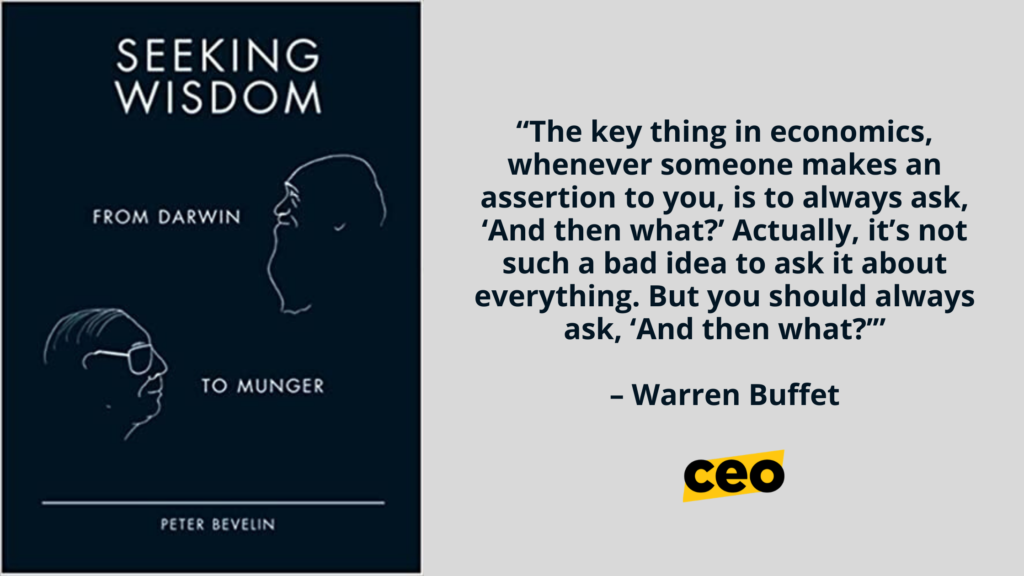
Seeking Wisdom: From Darwin to Munger (Peter Bevelin) — In this magical book, Peter explores a simple question, “How do we achieve wisdom?” What do we want from life? What interferes with our goals (of being happy)? Peter puts you in a sidecar and takes you along on his search for wisdom. Rather than tour his own life solely for learnings, he visits the journals of other successful people. “My quest for wisdom originates partly from making mistakes myself and observing those of others but also from the philosophy of Charles Munger. A man whose simplicity and clarity of thought is unequal to anything I have seen,” he reveals. Peter’s book is a fascinating collection from Munger, Warren Buffet, Darwin, Einstein, and Feynman. It is a book I personally read, put down, and pick up again. Each time, I uncover treasures of timeless learning.
My Favorite Mental Model>>> I enjoyed Wanted and Unwanted Consequences or Second-Order Consequences. Anchored from the concept of systems thinking. Within a system, every decision has one initial consequence and many follow-on consequences. One must think through those second-order consequences using a series of “and then what?” questions. In answering those questions, you will surely find potentially unwanted consequences. So, it’s important to pay attention to the whole system in the short and long term. Then judge a decision by its net consequences over time.
Read this excellent book summary of Seeking Wisdom by young Nat Eliason.
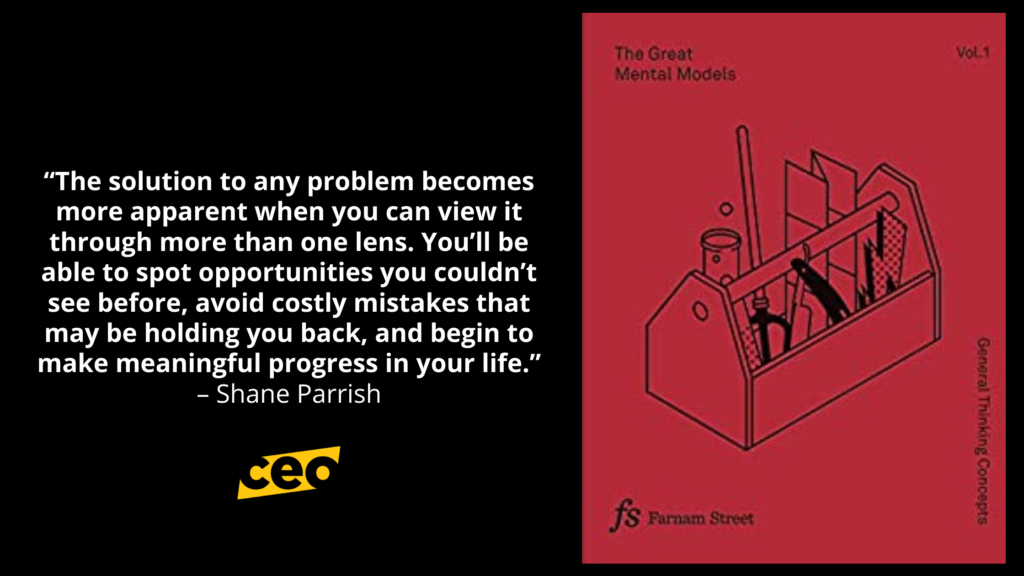
The Great Mental Models: General Thinking Concepts (Vol.1) | Physics, Chemistry and Biology (Vol.2) (Shane Parrish) — Shane is the founder of Farnam Street, a blog read by millions of people all over the world, including some of the best minds in finance, venture capital, and entrepreneurship. He is a computer scientist and a former Spy for Canada’s version of the NSA. At some point during his high-pressure career, he experienced decision-fatigue and decided to leave the agency and launch on a self-improvement journey. Along the way, he found Charlie Munger and Farnam Street was born. Shane’s mantra is, “the quality of your thinking depends on the models that are in your head.” The Great Mental Models series represents the books he wishes he had when he started learning about mental models. The first two volumes (three more to come) are beautifully produced curations–including ideas from Peter Bevelin– that take the reader through a tour of mental models using vivid, thoughtful examples. I personally read a chapter every evening, and these books will surely become generational gifts for my children and their children. I can feel my brain muscles growing already.
My Favorite Mental Model>>> I really like Inversion (from Vol.1), the concept that problems can be often solved by reversing. For instance, the question “how do I win more deals?” can be reframed as “how do I lose fewer deals?”– this version focuses your attention on understanding why you have lost a deal and finding ways to avoid it in the future. In other words, what would have to be true to never lose sales? The beauty of this model is that it can be applied to any problem and accelerate your progress.
Listen to Shane explain to Rich Roll about how mental models can help you live a better life.
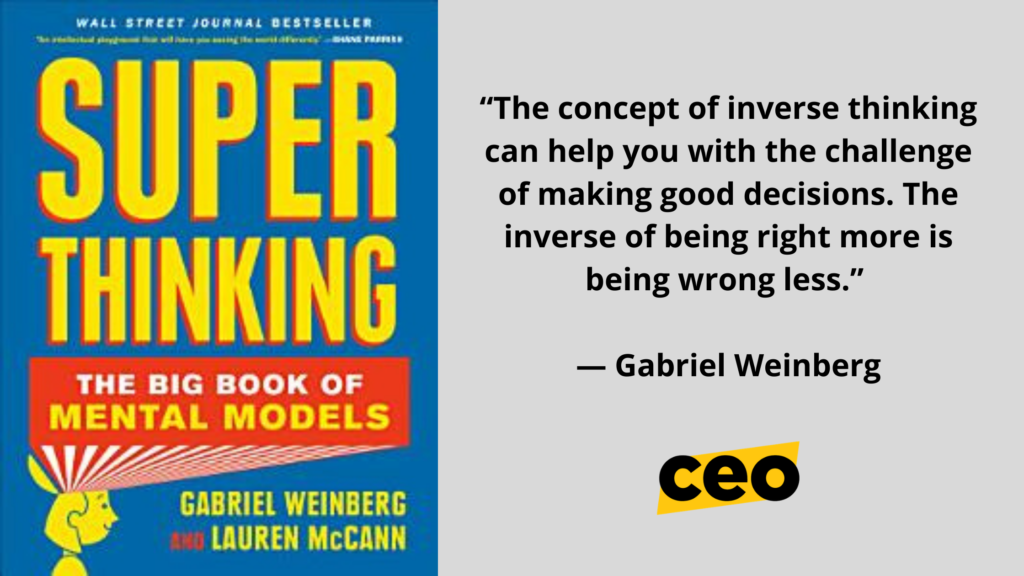
Super Thinking: The Big Book of Mental Models (Gabriel Weinberg and Lauren McCann) — This husband and wife team does a fantastic job of creating a lifetime reference of mental models. It’s like weightlifting for the brain. Gabriel is the founder of DuckDuckGo (the web browser that doesn’t track you). He has been fascinated with mental models for some time. As he thought about how best to help his team grow as leaders and scale, he thought it best to teach them to make better decisions. To make better decisions, it turns out, it’s best to build a latticework of multidisciplinary learning. The book does a fantastic job of categorizing and grouping mental models by their potential applications, such as dealing with conflict or time management.
As Gabriel puts it, “. . . I’m really asking you to ignore jurisdictional boundaries. If you want to be a good thinker, you must develop a mind that can jump these boundaries. You don’t have to know it all. Just take in the best big ideas from all these disciplines. And it’s not that hard to do.”
I made it mandatory reading for everyone in my company.
My Favorite Mental Model>>> I really like the Eisenhower Decision Matrix, which is a great model for understanding how to best manage your time as a CEO. Your time is as a CEO is very valuable, and it must be used wisely. Learning to assess what is an important activity and what is not. I always say how important it is to focus on the boulders, not the pebbles. This is a 2 x 2 matrix that organizes activities, investment, decision making as (1) high impact or low impact activities, and (2) high or low cost (time, money, focus, etc.). You want to focus all your attention on the high-impact, low-cost events.
Listen to Shane explain to Rich Roll about how mental models can help you live a better life.
As my super-bright friend Dip Patel and entrepreneur wrote after he read it, “the thing is, the more models you can learn, and start to employ as instinct, the deeper you will understand the world.”
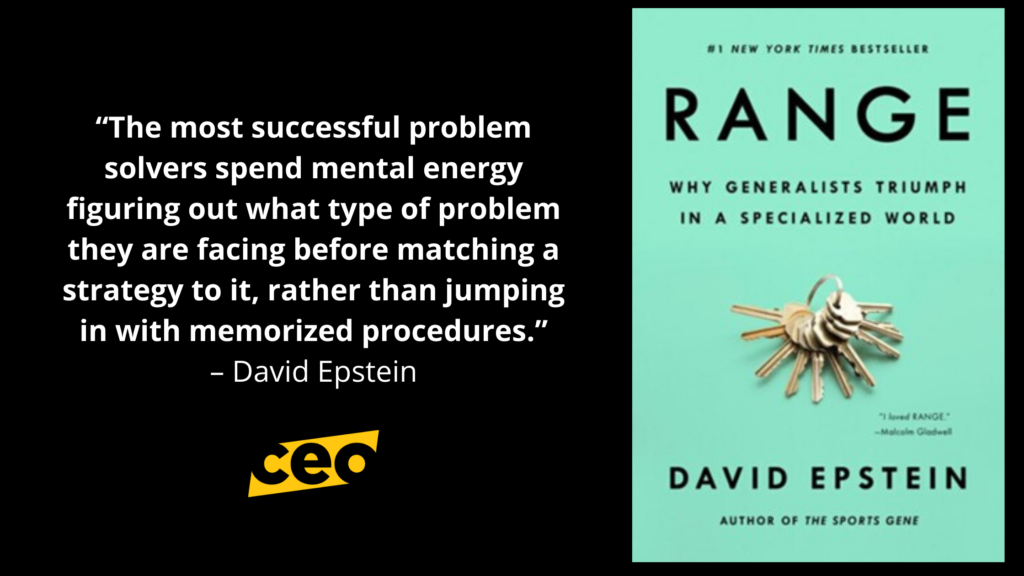
Range: Why Generalists Triumph in a Specialized World (David Epstein) — For years, I have been recommending Malcolm Gladwell’s work to young readers and young professionals alike. My first book, The Tipping Point, was an eye-opener for me, and I have been a fan ever since. About a decade ago, I held court with kids just about to head to college, and I shared the insights I gained from Malcolm’s seminal book—Outliers. I focused on the concept that 10,000 hours is the golden rule of mastery. And, that mastery was key to a winning career. David Epstein shattered that perspective.
My wife and I hosted our first book club with the same people—who were now young professionals—and worked to instill another idea. Specialization may be overrated.
I highly encourage this book as it helps answer a quintessential question: should my startup hire generalists or specialists? (I provide an unlikely answer here.)
It made me take a closer look at my own career and what has made me successful.
My Favorite Mental Model>> My favorite idea is Lateral Thinking. This is the notion that innovation need not require specialization in an area, but a novel combination of existing ideas from different disciplines. In fact, there has been a rapid increase in patents by generalist inventors (and polymaths) that significantly surpass specialists. It is believed that the ubiquity of the internet is one of the factors at play here. One of David’s enlightening examples involves the story behind Nintendo. “[Gunpei] Yokoi [creator of the Gameboy] called his creative philosophy’ lateral thinking with withered technology’. What he meant by lateral thinking was taking information from one area that may not be new, but just bringing it somewhere else where suddenly it’s new to that area, combining technologies in ways that other people hadn’t. By withered technology, he meant this older, well understood, often cheaper technology, so he didn’t have to worry about competing at the cutting edge.” Thus, the next time you want to solve a gnarly problem, give it to a generalist.
Watch this thought-provoking interview of David by Malcolm Gladwell at MIT.
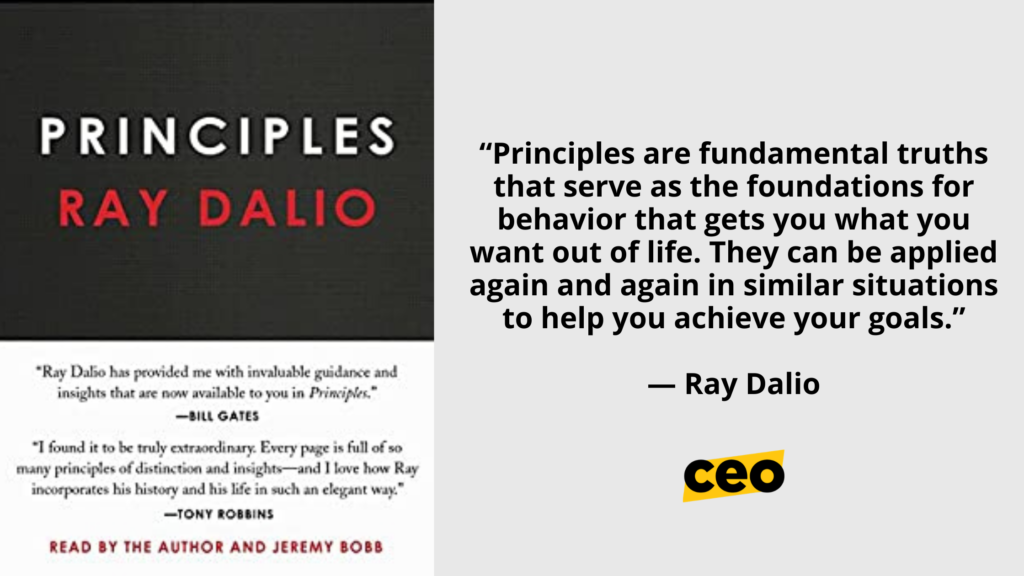
Principles: Life and Work (Ray Dalio) — Dalio’s book is a reference guide for self-reflection. He exemplifies, “pain is where the learning is” — another phrase I like to use with new CEOs. Dalio starts the book with a candid account of his own hubris-driven bet that costs him his company. After that experience, he was so broke that he had to borrow money from his dad to take a trip to Texas for a consulting gig. Dalio then embarks on a journey of introspection that ushers him to a world. There he cracks the code on the economy. He writes it down in a set of principles. He calls it “the machine.” (Funny enough, I love automata theory from computer science and enjoy the analogy.)
His company, Bridgewater Associates, uses this insight and associated mental models to create the most successful hedge fund in history. The principles in this book are quite helpful. He spells out how to learn from your mistakes. How to build a team that thrives on finding the best ideas and acting on them. He discusses the need to be “radically transparent.” And, most importantly, he explains how to make better decisions. He also talks about the importance of understanding what I call “the wiring” of each member of your team. He then combines all of this with sophisticated algorithms to simulate the machines in the real world.
My Favorite Mental Model>> My favorite idea is Look to Nature to Learn How Reality Works. It’s based on the notion that all the laws in nature can be used to realize our goals, it’s just a matter of learning the difference between what is true and what we want to be true. Our unique ability for abstract thinking makes this possible. As Ray puts it, “when trying to understand anything–economics, markets, the weather, …” he takes a top-down approach to find the laws that derive them. So, he has studied DNA because it explains the universal code for all species from the top down. Ray also talks about the importance of the second-order consequences of decisions.
Here is a gripping interview of Dalio on one of my favorite podcasts, The Knowledge Project.
So, I am thinking about forming an exclusive group of CEOs interested in Mental Training.
It will take on one or more of the following forms:
- A short email course on mental models
- A discussion group where we unpack mental models we’re learning and their applications
- Specially designed flashcards to help you master the models
If you’re interested in upgrading your thinking skills, fill out this short form to join the Mind Meld waitlist.


